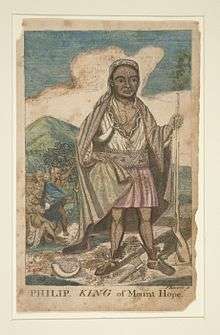Attack on Springfield
The Attack on Springfield (October 1675) was an Indian attack on the settlement of Springfield, Massachusetts during King Philip's War. Springfield was the second and final major New England settlement burnt to the ground during the war. (The first major settlement burned was Providence, Rhode Island.) King Philip's War permanently ended the harmonious relations that had existed between Springfield's settlers and the region's natives, and resulted in decimating 82% of the Native American warriors, and 23% of European settlers. The Attack on Springfield was one of the Native Americans greatest successes during King Philip's War.[1]

Background
In 1675, the leader of the Eastern Massachusetts Wampanoag Indian tribe, Wamsutta, died shortly after being questioned at gunpoint by Plymouth Colonists. Wamsutta's brother, Chief Metacomet (known as "King Philip") who had long been friendly and helpful to European settlers, took revenge. Initially inciting only his own tribe to rebel against the English colonists, he later toured New England, seeking support from other tribes to rise against their local English settlers.
Until this point, the Connecticut River settlers at Springfield had enjoyed arguably New England's most peaceful and mutually advantageous relationships with local natives.[1] The Mawaga Indians (of the Pocomtuc tribe) had been particularly accommodating to Springfield's settlers, ever since their first meeting with its initial scouts from Roxbury, Massachusetts in 1635. Likewise, Springfield's settlers - following the peaceful and business-minded example set by the settlement's founder, William Pynchon - had been equally accommodating to the area's Natives. Unlike settlements to Springfield's immediate south - such as Hartford, Connecticut, which had fought the Pequot Wars, and often treated Natives as opposition - during its first 39 years of existence, Springfield did not suffered an Indian raid. Until 1675, it had been very common to see Natives walking through Springfield's streets, visiting with English settlers and patronizing local businesses.[1]
King Philip visits Springfield
This harmony ended in 1675, when King Philip himself visited Springfield's Mawaga (Pocomtuc) Indians, at their fort on what is now Longhill Street in Springfield's South End. After King Philip met with the Mawaga in their fort, hundreds of Mawaga Indians moved to the area of Springfield now known as "King Philip's Stockade," (currently in Forest Park, a large city park bordering Longmeadow, Massachusetts.) There, King Philip was reported to incite the Mawaga Indians to rebel against the English settlers of Springfield and burn the town to the ground. Luckily, Springfielders received advance warning of this attack from a native from Windsor, Connecticut, named Toto, who in history books is often called "The Windsor Indian."[1] Currently, a bronze statue of Toto, the Windsor Indian, stands in King Philip's Stockade as a tribute to his bravery.
Attack
Despite the advance warning, 45 of Springfield's 60 houses were burned to the ground, as were its grist and saw mills, which belonged to village leader John Pynchon. Indeed, much of the town became smoldering ruins, and there was considerable thought given to abandoning it entirely.[2] This idea was rejected, and the residents of Springfield endured the winter of 1675 under siege conditions. During that winter, Captain Miles Morgan's block-house became Springfield's fortress. Many of the town's survivors lived there throughout the Attack on Springfield.
Under the cover of night, Morgan sent one of his paid Indian servants to Hadley, where Massachusetts Bay Colony troops under the command of Major Samuel Appleton were stationed. After alerting Appleton to Springfield's plight, his troops marched to Springfield and raised the siege.[1]
Aftermath and legacy
During King Philip's War, over 800 settlers were killed and approximately 8,000 Natives were killed, enslaved, or made refugees.[3] The war ended in the summer of 1676, when colonists shot Metacomet twice with a musket, leading to the Native Americans' surrender.[3] Following the war, Springfield Natives - who had been frequently seen around town in the years preceding the war - were rarely seen.[1] Thereafter, the fighting between the Connecticut River Valley's original native inhabitants and the English colonists continued for over 100 years, sometimes aided and abetted by New France.[3] The peace that had enabled the settlement at Springfield to flourish in its early years was forever broken.
References
- 1 2 3 4 5 6 King, Moses (1885). King's Handbook of Springfield, Massachusetts. Franklin Press. p. pg. 9. ISBN 9781152362826.
- ↑ "Homes For Sale in Springfield MA Real Estate". Massrealty.com. Retrieved 2012-07-09.
- 1 2 3 "Springfield, MA - Our Plural History". Ourpluralhistory.stcc.edu. Retrieved 2012-03-23.